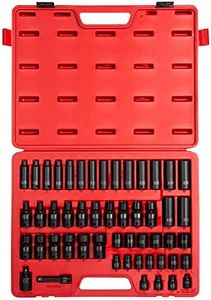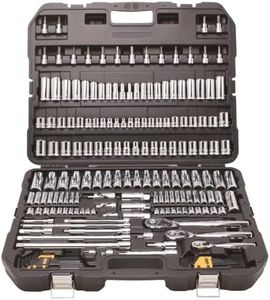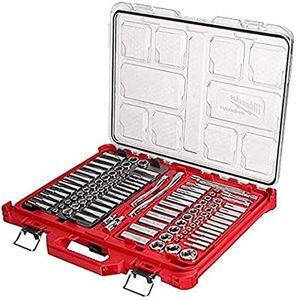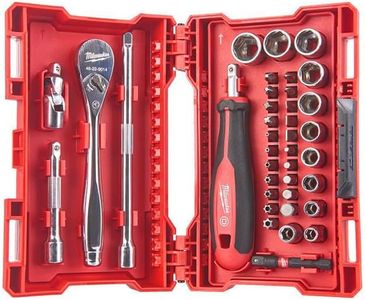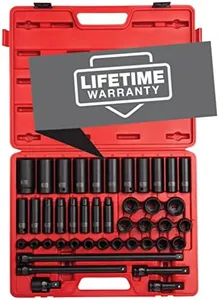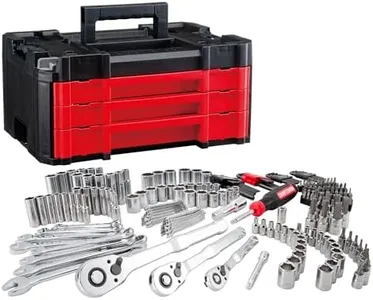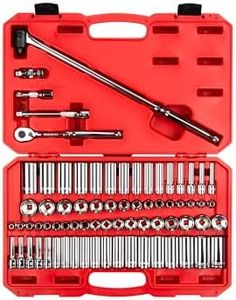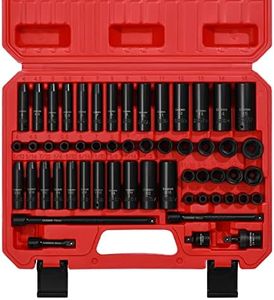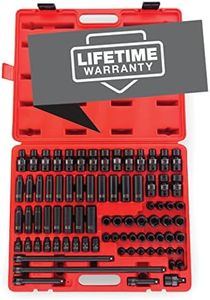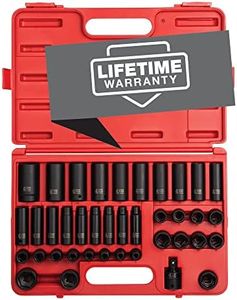We Use CookiesWe use cookies to enhance the security, performance,
functionality and for analytical and promotional activities. By continuing to browse this site you
are agreeing to our privacy policy
10 Best Socket Sets
From leading brands and best sellers available on the web.By clicking on a link to a third party's website, log data is shared with that third party.
Buying Guide for the Best Socket Sets
Choosing the right socket set can make general maintenance, repairs, and DIY projects much more efficient and enjoyable. When selecting a socket set, it's important to focus on how you'll use it. Are you looking to work on cars, bicycles, plumbing, or general household tasks? By understanding the core features of socket sets and relating them to your needs, you can ensure you invest in a set that makes your tasks easier and less frustrating.Drive SizeDrive size refers to the size of the square connector on your ratchet and the corresponding sockets. The most common sizes are 1/4-inch, 3/8-inch, and 1/2-inch. Smaller drive sizes, like 1/4-inch, are great for lighter, more delicate tasks and for getting into tight spaces, while larger sizes, like 1/2-inch, provide more torque for heavy-duty jobs such as car or machine work. For general versatility, many people start with a 3/8-inch set. Choose a drive size based on what you most often work on: smaller sizes for electronics and lighter tasks, larger sizes for vehicles and big bolts.
Socket Type (6-point vs. 12-point)Socket points refer to how the socket grips a nut or bolt. A 6-point socket grips each corner of a hexagonal nut tightly, making it less likely to slip or round off fasteners—ideal for high-torque situations. A 12-point socket has more engagement points, making it easier to fit onto a nut in cramped spaces but is more likely to slip under heavy force. If you work mostly on vehicles or need high torque, 6-point sockets are safer, but for more general or lighter work in tight spaces, 12-point sockets can be handy.
Material and FinishThe material and finish of sockets affect both their strength and longevity. Chrome vanadium steel is widely used for its balance of strength and rust resistance, often with a polished chrome finish that's easy to clean and resists corrosion. Some higher-end sockets may have additional coatings for added durability. When picking, think about where you'll store and use the tools: if they'll be exposed to damp or outdoor environments, the more resistant the finish, the better.
Socket Range (Sizes Included)The range of socket sizes in a set determines what bolts and nuts you can work with. Sets can span from just a few pieces up to 100 or more, including both metric and imperial (SAE) measurements. For work on cars made outside the US or bicycles, you'll often need metric sizes. For US-made machinery or older equipment, SAE sizes are more useful. Consider what you'll be tackling: a set covering both metric and SAE sizes offers maximum flexibility.
Accessories IncludedMany socket sets come with useful accessories like ratchets, extension bars, universal joints, and adapters. Extension bars help you reach bolts in tight spaces, while universal joints allow you to work at odd angles. Adapters let you use different drive sizes together. Think about whether you’ll be working in hard-to-reach spaces or needing more flexibility—if so, having these accessories in your set can save time and hassle.
Case and OrganizationA well-organized and durable case makes it much easier to keep track of your sockets and transport your set. Some cases are compact and sturdy, helpful if your tools will be moved around a lot or stored in different locations. Look for sets where every socket has a clearly labeled spot; this saves time and prevents loss. If you're always working in the same place, organization may be less crucial, but for mobile or occasional users, a good case is very valuable.

